African Violets are usually grown for their flowers. But even the most carefully tended and fertilized African violet won't bloom constantly. Variegated foliage makes some varieties exciting even when they're out of bloom. Imagine leaves so lovely that blooms are a bonus...
If you're used to seeing the plain green leaves of African violets on grocery store shelves, the contrasting tones of variegated varieties come as a delightful surprise. Some varieties have just a touch of white variegation on the leaf margins or tan variegation at the crown. Other varieties are strikingly colored all over with bold splashes of white, cream, and even pink. A red back or “red reverse” may further intensify the colors of the foliage, making the plant seem to glow even without blooms.
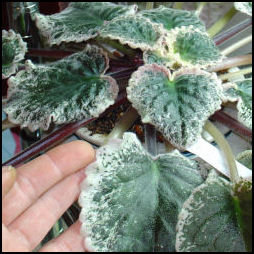
Edge variegation and red reverse
on leaves of 'Buckeye Boysenberry'
Variegation occurs in several distinct patterns. Edge variegation results in color differences along the margins of the leaves, while the midribs remain green. This is often called Tommie-Lou variegation, after the hybridizer Tommie Louise Oden. In crown variegation, the variegated color is limited to the leaves in the center, or crown, of the plant and is lost as leaves mature and grow outward. Ethyl Champion developed many varieties with this type of variegation, and her name is often associated with it. Mosaic variegation produces tiny streaks and splashes of color throughout the entire surface of the leaf.
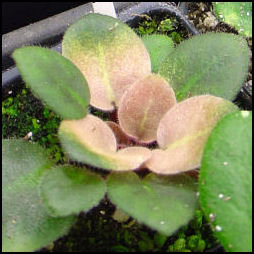
'Rob's Love Bite'
crown variegated plantlet
If you have a “variegated” variety that looks entirely green to you, don't worry. Variegation tends to be variable. Sometimes variegation will be lost when a plant is propagated, but more often it is temporarily gone due to some environmental condition. Many of my variegated plants grow out green during the warmer summer months. During cooler winter conditions, their striking colors return. Too much light or too much fertilizer may also “green up” a variegated plant. If your plant once had variegated leaves, odds are good that it will have them again.
When propagating a variegated African violet, choose a leaf cutting that has as much green as possible. The developing plantlets need the green chlorophyll in the mother leaf to provide energy. Sometimes plantlets will form that are entirely white or pink, without any green. If you separate these from the mother leaf, they probably won’t survive. A little weak fertilizer or fish emulsion may green them up.
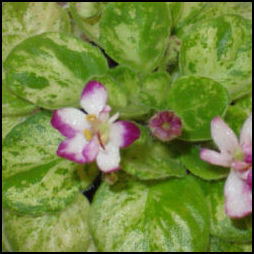
'Raspberry Sizzle'
with mosaic variegation
African violets with a lot of variegation need less light and are more likely to be burned by too-bright light. They’d rather be a little further from the window than their deep green siblings. If you're growing under fluorescent lights, the cooler ends of the fluorescent tubes are ideal locations for highly variegated plants.
You can find named cultivars of African violets with specific types of variegation and other characteristics by doing an advanced search through African violet entries in PlantFiles.
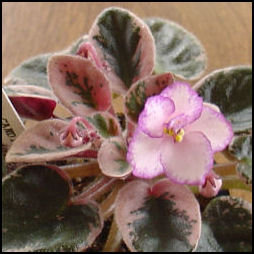
'Candy Crystals'
Where can you get these plants? Although variegated African violets are sometimes sold at local nurseries or “big box” stores, mail order vendors may be better sources. Many of the excellent companies mentioned in the African violet care and related links “sticky” thread near the top of the African Violets and Gesneriads forum (subscribers only) are also rated in the Garden Watchdog. Trading leaves and plantlets with other forum enthusiasts is also an excellent way to try new varieties.
I love variegated African violet plants, whether or not they are in bloom. With flowers, a variegated African violet is stunning. Without a single bud, it's still beautiful. Variegated varieties are less common but well worth searching out. Pick up an African violet or two with such lovely leaves, and soon you’ll be viewing blooms as a bonus!
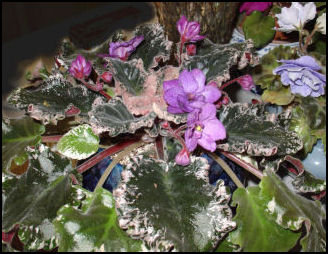
'Grape Slush'
Photographs by Jill M. Nicolaus.
For definitions of variegation types and other African violet terminology, see the Optimara Glossary of Violet Terms.
For additional information on growing African Violets, see the African Violet and Gesneriad forum here on DG or go to AVSA.org.
This article was originally published on February 16, 2008






 Edge variegation and red reverse
Edge variegation and red reverse 'Rob's Love Bite'
'Rob's Love Bite' 'Raspberry Sizzle'
'Raspberry Sizzle'  'Candy Crystals'
'Candy Crystals'  'Grape Slush'
'Grape Slush'